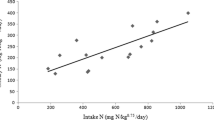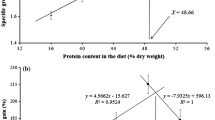Summary
Kittens fed diets containing 2.0 and 3.0 times (X) the NRC (1986) essential amino acid (EAA) requirement (EAArq) and 210 to 560g crude protein (CP)/kg diet had growth rates and plasma amino acid patterns that were not significantly different than kittens fed a control diet (CD) containing 1.5 X EAArq and 350 g CP/kg diet. Growth rates of kittens fed diets containing only EAA (with nontoxic levels of arginine and methionine) and 280 to 460 g CP/kg diet were equivalent to those of kittens fed CD. Kittens fed only EAA and 140 and 210 g CP/kg diet had growth rates that were significantly lower than kittens fed CD. Since the growth rate of kittens fed 1.5X EAArq and 210 g CP/kg diet in a previous experiment was equivalent to kittens fed CD (Taylor et al., 1997), it is suggested that the requirement for CP is higher (up to 280 g CP/kg diet) when only EAA are fed. The higher crude protein requirement appears to be primarily a consequence of the high obligatory nitrogen loss as urea (especially from arginine) incurred in the conversion of nitrogen from EAA to dispensable amino acids in the liver and secondarily because of a slow rate of catabolism of the EAA. A 3-dimensional plot of weight gains vs. CP levels and EAA to total nitrogen (E: T) ratios of kittens shows a broad range of CP levels and E: T ratios that support optimal growth in the kitten. It is suggested that similar patterns would occur in the chick, rat and other species if adverse effects caused by excesses of specific amino acids are avoided.
Similar content being viewed by others
References
Adkins JS, Wertz JM, Hove EL (1966) Influence of nonessential L-amino acids on growth of rats fed high levels of essential amino acids. Proc Soc Exp Bio Med 122: 519–523
Anderson PA, Baker DH, Sherry PA, Corbin JE (1980) Nitrogen requirement of the kitten. Am J Vet Res 41: 1646–1649
Bedford MR, Summers JD (1985) Influence of the ratio of essential to nonessential amino acids on performance and carcass composition of the broiler chick. Br Poultry Sci 26: 483–491
Bedford MR, Summers JD (1988) The effect of the essential to nonessential amino acid ratio on turkey performance and carcass composition. Can J An Sci 68: 899–906
Biourge V, Groff JM, Fisher C, Bee D, Morris JG, Rogers OR (1994) Nitrogen balance, plasma free amino acid concentrations and urinary orotic acid excretion during longterm fasting in cats. J Nutr 124: 1094–1103
Coulson RA, Hernandez T (1968) Amino acid catabolism in the intact rat. Am J Phys 215: 741–746
Deady JE, Anderson B, O'Donnell III JA, Morris JG, Rogers OR (1981) Effects of level of dietary glutamic acid and thiamin on food intake, weight gain, plasma amino acids and thiamin status of growing kittens. J Nutr 111: 1580–1585
Hammer VA, Rogers OR, Morris JG (1996) Dietary crude protein increases slightly the requirement for threonine in kittens. J Nutr 126: 1496–1504
Hargrove DM, Rogers OR, Calvert CC, Morris JG (1988) Effects of dietary excesses of the branched-chain amino acids on growth, food intake and plasma amino acid concentrations of kittens. J Nutr 118: 311–320
Harper AE (1974) “Nonessential” amino acids. J Nutr 104: 965–967
Harper AE, Benevenga NJ, Wohlhueter RM (1970) Effects of ingestion of disproportionate amounts of amino acids. Physiol Rev 50: 428–558
Heger J (1990) Non-essential nitrogen and protein utilization in the growing rat. Br J Nutr 64: 653–661
Herwill A (1994) Effect of excess L-tyrosine and L-tryptophan added to a low protein diet for growing kittens. Master's thesis, University of California, Davis, California
National Research Council (1985) Guide for the care and use of laboratory animals. Publication no. 85-23 (rev.), NIH,Bethesda, MD
National Research Council (1986) Nutrient requirements. In: Nutrient requirements of cats, rev edn. National Academy Press, Washington, D.C., pp 3–28
National Research Council (1978) Nutrient requirements. In: Nutrient requirements of laboratory animals, rev edn. National Academy Press, Washington, D.C., pp 13–15
National Research Council (1984) Nutrient requirements. In: Nutrient requirements of poultry, rev edn. National Academy Press, Washington, D.C., pp 2–15
Rogers QR, Morris JG(1991) Nutritional peculiarities of the cat. In: Leibetseder J (ed) Proceedings of the XVI WSAVA World Congress, Vienna, Austria, pp 261–266
Rogers OR, Morris JG, Freedland RA (1977) Lack of hepatic enzymatic adaptation to low and high levels of dietary protein in the adult cat. Enzyme 22: 348–356
Smalley KA, Rogers QR, Morris JG, Eslinger LL (1985) The nitrogen requirement of the weanling kitten. Br J Nutr 53: 501–508
Stein TP, Settle RG, Albina JA, Dempsey DT, Melnick G (1986) Metabolism of nonessential15N-labeled amino acids and the measurement of human whole-body protein synthesis rates. J Nutr 116: 1651–1659
Stucki WP, Harper AE (1961) Importance of dispensable amino acids for normal growth of chicks. J Nutr 74: 377–383
Stucki WP, Harper AE (1962) Effects of altering the ratio of indispensable to dispensable amino acids in diets for rats. J Nutr 78: 278–286
Taylor TP, Morris JG, Willits NH, Rogers QR (1996) Optimizing the pattern of essential amino acids as the sole source of dietary nitrogen supports near-maximal growth in kittens. J Nutr 126: 2243–2252
Taylor TP, Morris JG, Kass PH, Rogers QR (1997) Increasing dispensable amino acids in diets of kittens fed essential amino acids at or below their requirement increases the requirement for arginine. Amino Acids 13: 257–272
Wang TC, Fuller MF (1989) The optimum dietary amino acid pattern for growing pigs 1. Experiments by amino acid deletion. Br J Nutr 62: 77–89
Williams JM, Morris JG, Rogers QR (1987) Phenylalanine requirements of kittens and the sparing effect of tyrosine. J Nutr 117: 1102–1107
Wiseman G (1964) Protein. In: Wiseman G (edd) Absorption from the intestine. New York, pp 63–65
Author information
Authors and Affiliations
Additional information
Presented in part at the Biology '96 Meeting in Washington, DC [Taylor TP, Deberry J, Morris JG, Rogers QR (1996) Effects of dietary nitrogen level and essential amino acid: total nitrogen (E: T) ratio on kitten weight gain. FASEB J 10: A737 (abs. 4259)] and in part at the Proceedings of the Waltham International Symposium, “Pet Nutrition and Health in the 21st Century”, Orlando, Florida, USA [Rogers QR, Taylor TP, Morris JG (1997) Optimizing dietary amino acid patterns at various levels of crude protein for the cat. J Nutr (abs.) (in press).
Rights and permissions
About this article
Cite this article
Taylor, T.P., Morris, J.G., Kass, P.H. et al. Maximal growth occurs at a broad range of essential amino acids to total nitrogen ratios in kittens. Amino Acids 15, 221–234 (1998). https://doi.org/10.1007/BF01318861
Received:
Accepted:
Issue Date:
DOI: https://doi.org/10.1007/BF01318861




